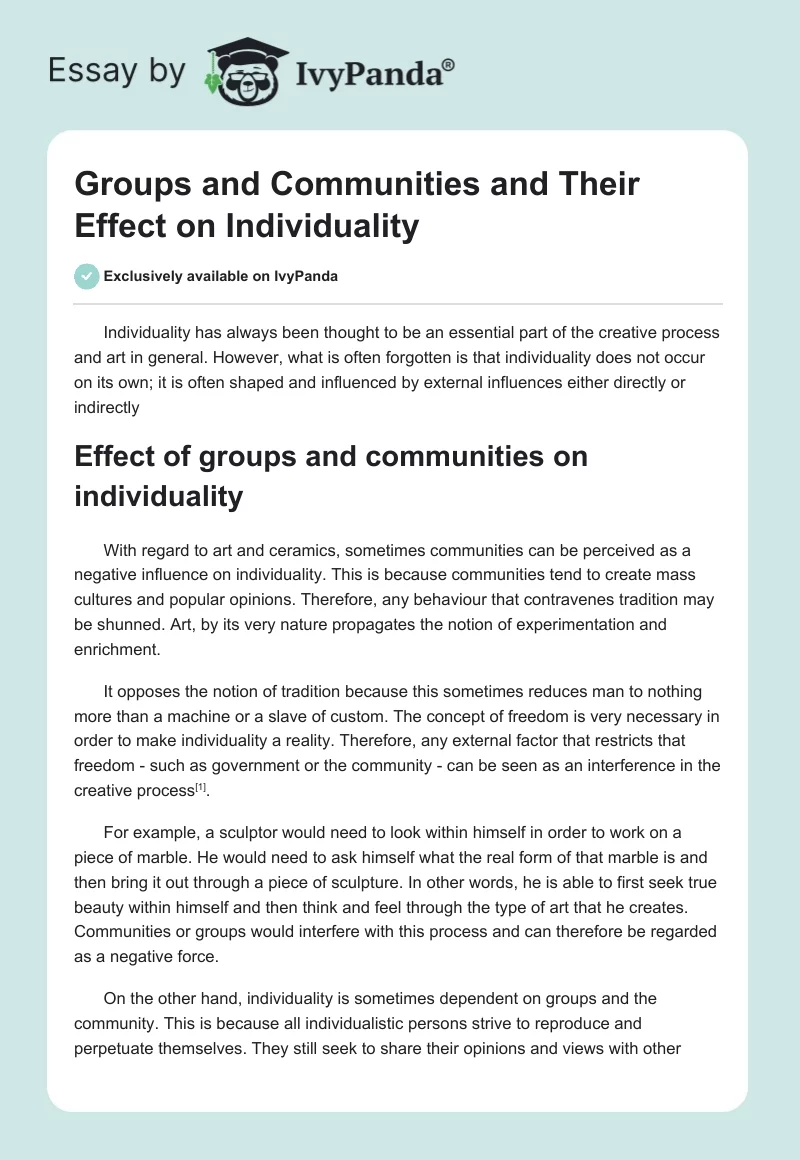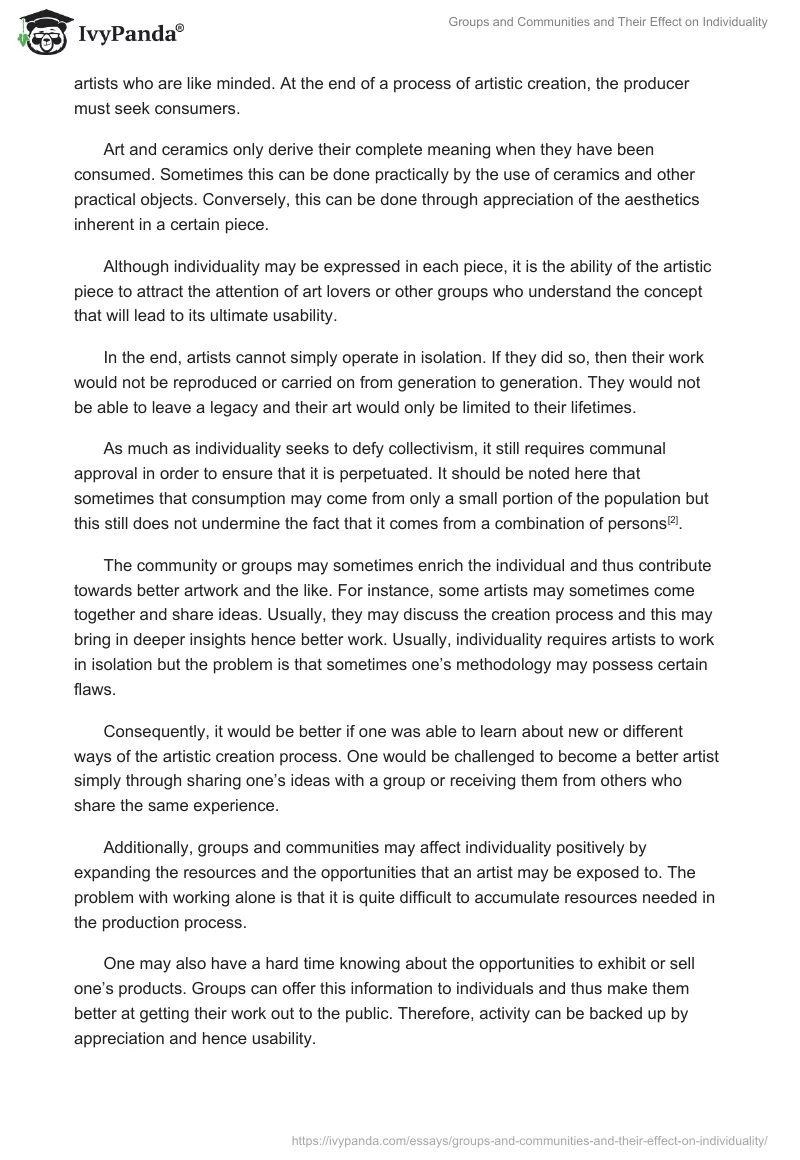Individuality has always been thought to be an essential part of the creative process and art in general. However, what is often forgotten is that individuality does not occur on its own; it is often shaped and influenced by external influences either directly or indirectly
Effect of groups and communities on individuality
With regard to art and ceramics, sometimes communities can be perceived as a negative influence on individuality. This is because communities tend to create mass cultures and popular opinions. Therefore, any behaviour that contravenes tradition may be shunned. Art, by its very nature propagates the notion of experimentation and enrichment.
It opposes the notion of tradition because this sometimes reduces man to nothing more than a machine or a slave of custom. The concept of freedom is very necessary in order to make individuality a reality. Therefore, any external factor that restricts that freedom – such as government or the community – can be seen as an interference in the creative process[1].
For example, a sculptor would need to look within himself in order to work on a piece of marble. He would need to ask himself what the real form of that marble is and then bring it out through a piece of sculpture. In other words, he is able to first seek true beauty within himself and then think and feel through the type of art that he creates. Communities or groups would interfere with this process and can therefore be regarded as a negative force.
On the other hand, individuality is sometimes dependent on groups and the community. This is because all individualistic persons strive to reproduce and perpetuate themselves. They still seek to share their opinions and views with other artists who are like minded. At the end of a process of artistic creation, the producer must seek consumers.
Art and ceramics only derive their complete meaning when they have been consumed. Sometimes this can be done practically by the use of ceramics and other practical objects. Conversely, this can be done through appreciation of the aesthetics inherent in a certain piece.
Although individuality may be expressed in each piece, it is the ability of the artistic piece to attract the attention of art lovers or other groups who understand the concept that will lead to its ultimate usability.
In the end, artists cannot simply operate in isolation. If they did so, then their work would not be reproduced or carried on from generation to generation. They would not be able to leave a legacy and their art would only be limited to their lifetimes.
As much as individuality seeks to defy collectivism, it still requires communal approval in order to ensure that it is perpetuated. It should be noted here that sometimes that consumption may come from only a small portion of the population but this still does not undermine the fact that it comes from a combination of persons[2].
The community or groups may sometimes enrich the individual and thus contribute towards better artwork and the like. For instance, some artists may sometimes come together and share ideas. Usually, they may discuss the creation process and this may bring in deeper insights hence better work. Usually, individuality requires artists to work in isolation but the problem is that sometimes one’s methodology may possess certain flaws.
Consequently, it would be better if one was able to learn about new or different ways of the artistic creation process. One would be challenged to become a better artist simply through sharing one’s ideas with a group or receiving them from others who share the same experience.
Additionally, groups and communities may affect individuality positively by expanding the resources and the opportunities that an artist may be exposed to. The problem with working alone is that it is quite difficult to accumulate resources needed in the production process.
One may also have a hard time knowing about the opportunities to exhibit or sell one’s products. Groups can offer this information to individuals and thus make them better at getting their work out to the public. Therefore, activity can be backed up by appreciation and hence usability.
Culture is an essential part of the artistic process because artists do not live in islands by themselves; they live, interact and work with other members of society. Therefore, even though individualists may be self reliant and independent, they still operate within an institutional framework.
They have families and societies that have certain norms and expectations. These norms are not too rigid because they allow for manipulation and the expression of self through art. This is the reason why certain forms of art are unique to a certain part of the world. In the Asian countries, art was often unique to the culture of the people even as far back as the eighteenth century.
Similarly, certain kinds of art are peculiar to western societies and may not necessarily reach out to people in another part of the world such as Africa[3]. In essence, culture defines one’s artistic inclinations but it still leaves room for self expression. It can be thought of as the template against which artists exercise their own interests and creations. Therefore, individuality is intertwined with culture which is derived from communities.
Conclusion
Artistic work can sometimes be hampered by communities because it restricts the freedom of self expression. Communities have norms and traditions that are in direct contravention to self reliance and individuality. On the other hand, groups and communities may enrich artistic work through sharing ideas and also through culture identities.
References
- Josephs, W. & Synderman, G. (2010). The underworld of art.
- Swart, K. (1962). Individualism in the mid nineteenth century. History of ideas journal, 23(1), 77-90.
- Renault, A. (1999). The era of the individual. Princeton: Princeton university press.


